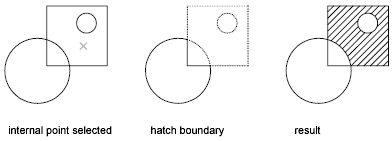HATCH Command
Fills an enclosed area or selected objects with a hatch pattern, solid fill, or gradient fill.
When the ribbon is active, the Hatch Creation contextual tab is displayed. When the ribbon is off, the Hatch and Gradient dialog box is displayed. If you prefer using the Hatch and Gradient dialog box, set the HPDLGMODE system variable to 1.
If you enter -HATCH at the Command prompt, options are displayed.

- To prevent memory and performance problems, the maximum number of hatch lines created in a single hatch operation is limited. However, you can change the maximum number of hatch lines with the HPMAXLINES system variable.
- To maintain performance for hatches with non-continuous hatch lines, choose a predefined hatch pattern rather than loading and setting a non-continuous linetype. Beginning with AutoCAD 2015-based products, the HPLINETYPE system variable suppresses the display of non-continuous linetypes in hatches by default.
- To control whether object snaps ignore hatch objects, add or subtract 1 from the OSOPTIONS system variable.
Choose from several methods to specify the boundaries of a hatch.
- Specify a point in an area that is enclosed by objects.
- Select objects that enclose an area.
- Specify boundary points using the -HATCH Draw option.
- Drag a hatch pattern into an enclosed area from a tool palette or DesignCenter.
The following prompts are displayed:
Pick Internal Point
Determines a boundary from existing objects that form an enclosed area around the specified point.

Select Objects
Determines a boundary from selected objects that form an enclosed area.

Remove Boundaries
(Available only when adding hatches from within the Hatch and Gradient dialog box)
Removes the hatch patterns added during the currently active HATCH command. Click the pattern you want to remove.
Add Boundaries
(Available only when adding hatches from within the Hatch and Gradient dialog box)
Switches from the Remove Boundaries mode so you can add hatch patterns again.
Undo
Removes the last hatch pattern you inserted with the currently active HATCH command.
Settings
Opens the Hatch and Gradient dialog box, where you can change settings.
Powered by AutoCAD®
Related Articles
DRAWORDER Command
Changes the draw order of images and other objects. Several options are available that control the order in which overlapping objects are displayed. In addition to the DRAWORDER command, the TEXTTOFRONT command brings all text, dimensions, or ...CHAMFER Command
Bevels or chamfers the edges of two 2D objects or the adjacent faces of a 3D solid. A bevel or chamfer is an angle line that meets the endpoints of two straight 2D objects. The distance and angles that you specify are applied in the order that you ...AutoCAD Keyboard Commands
Learning how to use AutoCAD keyboard commands can help you work faster and improve your efficiency. This article lists the abbreviated commands that can be used in AutoCAD (Toolbox). Toggle General Features Ctrl+G Toggle Grid Ctrl+E Cycle isometric ...3DPOLY Command
Creates a 3D polyline. A 3D polyline is a connected sequence of straight line segments created as a single object. 3D polylines can be non-coplanar; however, they cannot include arc segments. The following prompts are displayed: Start Point of ...ACTBASEPOINT Command
Inserts a base point or base point prompt in an action macro. As you record an action macro, you can use this command to insert a prompt for base point input. During playback, the macro pauses to display the prompt and does not continue until a ...
Recent Articles
Toolbox Release Notes | Build 25.1.1218.641
The following release notes apply to Toolbox build 25.1.1218.641 Part Properties Fixes A handful of issues centered around the Part Properties interface have been resolved: The Reference for Measurement tool in the interface has been fully removed ...Transferring Global Variables to a new Library
This article will explain the process of transferring customized Global Variables from your current library to a new installation of the Microvellum Foundation Library. The G! Workbook The Foundation Library contains all standard and custom data in ...Microvellum Foundation Library Release Notes | Build 25.1121
The following release notes apply to the Microvellum Foundation Library build 25.1121. Additions Added the new product, Master Island End Cabinet, to the Master Cabinets FF product category. Added the Nesting Optimization Report Select Processing ...Toolbox Release Notes | Build 25.1.1204.641
The following release notes apply to Toolbox build 25.1.1204.641 Toolbox Login Screen Update Fig. 1: The updated Toolbox Login interface. The Toolbox Login interface has had several changes applied to it to enhance its usability and allow for greater ...Toolbox Release Notes | Build 25.1.1120.641
The following release notes apply to Toolbox build 25.1.1120.641 Mouse Wheel Fix There was a reported issue in certain interfaces (such as report groups) in which hovering over a dropdown menu (such as Output Type) would result in the options within ...